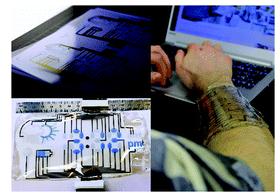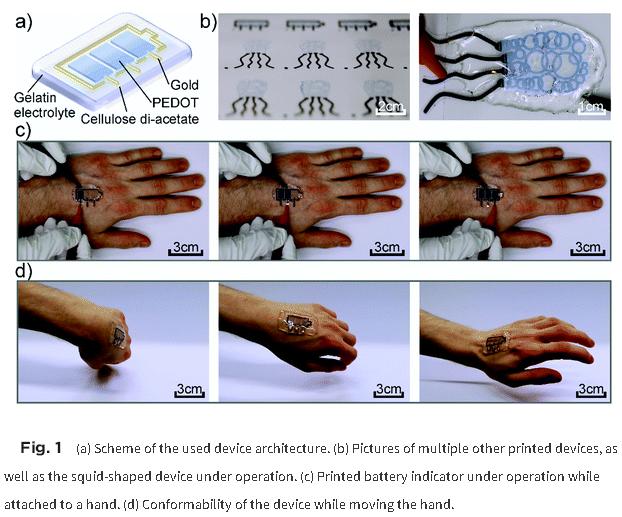博文
可生物降解显示器
||
可生物降解显示器
诸平


据德国卡尔斯鲁厄技术研究所(Karlsruher Institut für Technologie, KIT)2021年1月26日提供的消息,该研究所的研究人员开发出了可生物降解的印刷显示器,这对于可持续电子产品的开发意义非凡。
在未来的几年中,电子设备在消耗品中的使用越来越多,物联网的新技术也在增加电子废料的数量。为了节省资源并最大程度地减少浪费,将需要生态友好的生产和更可持续的生命周期。德国卡尔斯鲁厄技术学院的科学家现已成为生产显示器的第一位,其生物可降解性已通过独立办公室的检查和认证。相关研究结果已经在《材料化学杂志C辑》(Journal of Materials Chemistry C)上发表——Manuel Pietsch, Stefan Schlisske, Martin Held, Noah Strobel, Alexander Wieczorek, Gerardo Hernandez-Sosa. Biodegradable inkjet-printed electrochromic display for sustainable short-lifecycle electronics. Journal of Materials Chemistry C, 2020; 8 (47): 16716-16724. DOI: 10.1039/d0tc04627b
KIT的光技术学院( KIT's Light Technology Institute,KIT’s LTI)的研究员,也是《材料化学杂志C辑》论文的第一作者Manuel Pietsch说:“我们首次证明,借助工业相关的生产方法,可以生产主要基于天然材料的可持续显示器。使用后,这些显示器不是电子废料,而是可以堆肥的。结合使用通过回收和再利用,这可能有助于最大程度地减少或完全避免电子废料对环境的某些影响。”Manuel Pietsch目前在海德堡创新实验室(Heidelberg InnovationLab)工作。
能耗低,构造简单
此显示器的功能基于初始有机材料的所谓电致变色效应。施加电压后,光吸收会发生变化,并且材料会改变其颜色。与诸如LED,LCD和电子纸(E-paper)之类的商用显示器相比,电致变色显示器具有低能耗和简单的组件架构。另一个优点是这些显示器可以通过喷墨印刷定制,并且价格廉价,材料有效利用率高。此外,该过程适合于高吞吐量的扩展。使用的材料主要是天然来源的或生物相容的。用明胶密封可使显示器具有粘性和柔韧性,使其可以直接戴在皮肤上。
用于医疗诊断和食品包装
该显示器通常适用于各个领域的短生命周期应用。例如,在医疗诊断中起着重要作用,特别是那些传感器及其指示器在使用后必须清洗或丢弃。新开发的显示器不会作为电子废料倾倒,而是可堆肥的。它也可以用于不允许重复使用的食品包装质量监控。数字印刷可以使显示器适应个人或复杂的形状,而无需对该过程进行任何昂贵的修改,这无疑减少了资源消耗。
海德堡创新实验室LTI的印刷电子产品小组负责人,也是上述此项研究论文的通讯作者Gerardo Hernandez-Sosa说:“据我们所知,这是喷墨印刷生产的可生物降解显示器的首次展示。它将为其他电子元件的可持续创新和生态友好型电子产品的生产铺平道路。”更多信息请注意浏览原文或者相关报道。
The fabrication of electronics on the basis of biofriendly materials aims to counterbalance the negative trends conveyed by the short life-cycle of electronics. Furthermore, these materials open the possibility to develop optoelectronic technologies which will be in contact with the human body. In this work, we present an electrochromic display fabricated by resource- and energy-efficient digital printing techniques. The biodegradation of the device is certified under the ISO 14855 standard. The display comprises of a poly(3,4-ethylenedioxythiophene):polystyrene sulfonate (PEDOT:PSS) electrochromic layer, a gelatin-based electrolyte and Au electrodes deposited on a cellulose di-acetate substrate. We investigate the impact of various naturally sourced ionic species on the ionic conductivity of the electrolyte and the figures of merit of the display. The printed devices show an electrochromic contrast of 32 ± 4% and switching times of 3.0 ± 1.4 s, comparable to the spincoated reference devices. The utilization of inkjet printing enables the fabrication of different device designs with individually addressable pixels. The display can be worn innocuously on the skin without loss of performance thanks to the self-adhesion properties of the gelatin hydrogel. The present work highlights the use of industrial relevant technology for the fabrication of truly ecofriendly optoelectronic systems.
https://blog.sciencenet.cn/blog-212210-1269475.html
上一篇:COVID-19患者康复后免疫系统具有持久的防御能力
下一篇:新型生物传感器:可快速检测冠状病毒蛋白和抗体(附原文)